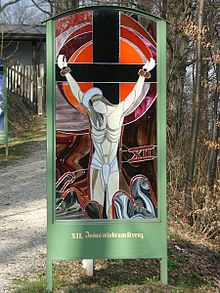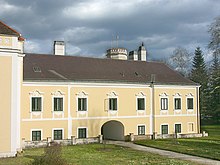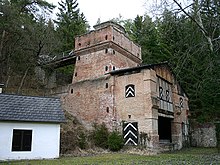Bad Erlach
|
market community Bad Erlach
|
||
|---|---|---|
| coat of arms | Austria map | |
|
|
||
| Basic data | ||
| Country: | Austria | |
| State : | Lower Austria | |
| Political District : | Wiener Neustadt-Land | |
| License plate : | WB | |
| Main town : | Erlach | |
| Surface: | 9.16 km² | |
| Coordinates : | 47 ° 44 ' N , 16 ° 13' E | |
| Height : | 312 m above sea level A. | |
| Residents : | 3,149 (January 1, 2020) | |
| Postcodes : | 2822, 2823, 2833 | |
| Area code : | 02627 | |
| Community code : | 3 23 06 | |
| NUTS region | AT122 | |
| UN / LOCODE | AT BRH | |
| Address of the municipal administration: |
Fabriksgasse 1 2822 Bad Erlach |
|
| Website: | ||
| politics | ||
| Mayor : | Johann Rädler ( ÖVP ) | |
|
Municipal Council : ( 2020 ) (21 members) |
||
| Location of Bad Erlach in the Wiener Neustadt-Land district | ||
| Source: Municipal data from Statistics Austria | ||
Bad Erlach ( Bad Erlach an der Pitten ) is a market town with 3149 inhabitants (as of January 1, 2020) in the district of Wiener Neustadt-Land in Lower Austria .
geography
Bad Erlach is located in the south-eastern industrial district in Lower Austria, at the exit of the Pitten valley in the Steinfeld and belongs to the Bucklige Welt region . A few meters northeast of Erlach is the confluence of the Pitten with the Schwarza , which from there form the Leitha .
The area of the market town covers 9.16 square kilometers. 50.67% of the area is forested. Bad Erlach has 680 buildings.
Community structure
The municipal area comprises the following three localities and cadastral communities of the same name (population in brackets as of January 1, 2020):
- Bad Erlach (2699 inhabitants, 6.59 km²)
- Brunn near Pitten (424 Ew., 1.57 km²)
- Linsberg (26 Ew., 1.01 km²)
The Rotten Vorderbrühl and brick kilns belong to the village of Bad Erlach.
Neighboring communities
The five neighboring communities of Bad Erlach are:
| Schwarzau am Steinfeld | Lanzenkirchen | |
|
Pitten ( Neunkirchen district ) |

|
Walpersbach |
| Scheiblingkirchen-Thernberg | Bromberg |
history
Before the birth of Christ, the area was part of the Celtic Kingdom of Noricum and belonged to the surroundings of the Celtic hill settlement Burg on the Schwarzenbacher Burgberg .
Later under the Romans, today's Bad Erlach was then in the province of Pannonia .
Erlach was first mentioned in 987 in a document lying in the castle church of Ebenfurth . In this it is stated that people from "Elira" built a thank you chapel for St. Ortisei. In 1045 "Erlaha" was first mentioned in a document as a village under the ministerials of the Counts of "Wels-Lambach".
Ulrichskirche was closed in 1780 under Emperor Josef II.
The era of industrialization began in Erlach in 1850 with the establishment of a spinning and weaving factory . On the initiative of Baron Kempen von Fichtenstein, the Ulrichskirche was renovated and reopened in 1858. In 1871 the previously independent municipality of Brunn-Linsberg was incorporated into the municipality of Erlach.
With the opening of the Aspang Railway on August 7, 1881, Erlach received the long-awaited railway connection , which had a particularly positive effect on the development of the economy.
On June 29, 1995, the Lower Austrian state parliament unanimously decided to raise Erlach to the status of a “market town”. The market survey ceremony took place as part of a large festival on September 5, 1996.
Together with the Lower Austrian state government and the Congregation of the Salvatorians, the construction of a retirement home was started in 2001, which today is an important economic agent of the community.
In 2004, drilling was successfully carried out in the area of the Linsberg cadastral community to develop thermal water. After initial financial problems, construction of the Linsberg thermal baths began in February 2007 and went into operation on August 8, 2008.
On March 22, 2007, the municipality of Erlach was given the name “ Bad ” Erlach in accordance with a resolution of the Lower Austrian state government .
On February 15, 2013, the groundbreaking ceremony for the construction of the health center took place and thus the first step towards the Bad Erlach health cluster. The 25 million euro project is supported by the state of Lower Austria and the Ecoplus regional funding on the initiative of the regional economist Petra Bohuslav . The new health center with 192 beds, which will be designed to treat cancer patients, is due to be completed by October 2014.
coat of arms
The municipality of Erlach was given a municipal coat of arms by resolution of the Lower Austrian state government on April 16, 1996.
Blazon :
- "In a blue shield, made of golden three-mountain, half a golden wheel, growing out of it a silver man, holding a silver staff with an Ulrich cross in his right hand, his left arm in his side."
At the same time, the community colors “yellow-blue-white” set by the council of the market town of Erlach were approved.
Population development
Bad Erlach is a prosperous municipality whose population has increased steadily since 1991. Bad Erlach has become more attractive, particularly through the creation of starter apartments for young families, the construction of residential complexes and the creation of inexpensive building sites. This is particularly underlined by the number of private households, whose number rose from 876 (1991) to 1,050 (2001).
According to the results of the 2001 census , the market town of Bad Erlach had 2,531 inhabitants. A survey of December 31, 2007 showed an increase of 10.8% to 2,729 residents within the last six years. Since the birth balance has developed negatively, this increase is due to the large influx.
The following graphic shows the population development of Bad Erlach since 1869:

- "Locally present population" on December 31, 1910 and March 7, 1923, respectively
- "Resident population" on March 22, 1934
- "Permanent population" plus the "professional military personnel" and the "Reich Labor Service" on May 17, 1939
- Official census on June 1, 1951, March 21, 1961, May 12, 1971 and 1981, May 15, 1991 and 2001
- Statistical data for Bad Erlach on December 31, 2005 and 2007
religion
According to the 2001 census data , 82.6% of the population were Roman Catholic , 1.4% Protestant and 4.1% Muslim . 0.9% belonged to Orthodox churches , 9.4% of the population had no religious denomination.
politics
The municipal council has 21 members.
- With the municipal council elections in Lower Austria in 1990, the municipal council had the following distribution: 12 SPÖ and 9 ÖVP.
- With the municipal council elections in Lower Austria in 1995, the municipal council had the following distribution: 12 SPÖ and 9 ÖVP.
- With the municipal council elections in Lower Austria in 2000, the municipal council had the following distribution: 11 ÖVP, and 10 SPÖ.
- With the municipal council elections in Lower Austria in 2005 , the municipal council had the following distribution: 16 ÖVP and 5 SPÖ.
- With the municipal elections in Lower Austria in 2010 , the municipal council had the following distribution: 17 ÖVP and 4 SPÖ.
- With the municipal council elections in Lower Austria in 2015 , the municipal council had the following distribution: 16 ÖVP, 4 SPÖ, and 1 FPÖ.
- With the municipal council elections in Lower Austria 2020 , the municipal council has the following distribution: 16 ÖVP, 4 SPÖ, and 1 FPÖ.
- mayor
|
|
|
|
Culture and sights
- Catholic parish church Bad Erlach hl. Anton: The St. Antonius Church (patron saint Antonius of Padua, June 13th patronage), built according to the plans of the then master builder of St. Stefan in Vienna, Prof. Karl Holey, replaced the nearby church, built in the 17th century The local chapel, built in the 18th century, is reminiscent of the brick industry that once dominated Bad Erlach, with the shape and the round tower of the building. The newly designed chancel in the parish church was opened in 1998 by Archbishop Dr. Consecrated to Christoph Cardinal Schönborn.
- Erlacher Madonna: The 166 cm tall wooden sculpture, created around 1320 to 1330, is one of those rare depictions of the Madonna where the child is held by Mary's right arm. It is not known how long the statue was in the Ulrichskirche before it was purchased by the Archbishop's Cathedral and Diocesan Museum in Vienna in 1939. In 1991 a copy of the Madonna was brought back to Erlach and placed in a niche in the Antonius Church.
- Ulrichskirche with forest cemetery and Stations of the Cross: The current Ulrichskirche dates from the 13th century, which is confirmed by the grave slab on the outside. It is believed that monks settled on the ridge much earlier. From 1945 a forest cemetery between Schwarzföhren was created around the church . Excavations carried out by the Institute for Prehistory and Early History in 1994 have revealed not only numerous skeletal remains but also remains of Roman walls. Access to the forest cemetery is provided by a way of the cross made of Tiffany glass panels designed by Bad Erlach glass artist Alois Hammer .
- Linsberg Castle: The “freye Thurmhof” in Linsberg, which was once surrounded by numerous towers, now gives the impression that the street leads right through the church.
- Brick kiln: There were once up to eleven brick kilns in Bad Erlach. The brick kiln on Bromberger Strasse, which is still in operation today, is the last remnant of this once flourishing branch of industry.
- Mill: The Bad Erlacher mill is one of the oldest buildings in the Bad Erlach community and is now home to the local history museum. It not only presents local history, but also the eccentric cave. The story of the miller who once mixed gypsum with his flour and was sentenced to death for it is also documented.
- Harrathof: The former aristocratic residence was first mentioned in documents in 1406 ("Nicolai de Harreth"). Later, the Reichersbergers were obliged to pay tithes. Today the Harrathof is privately owned. Interesting is the count's grave, which is to the left of the path at the edge of the forest. The inscription commemorates Count Luis de Rosiers, who died at Harrathof on October 14, 1813.
- The Bad Erlach local history museum is housed in the "Alte Mühle" at Altagasse 37. It includes around 500 exhibits:
- Showpieces on the subjects of school, household, trade, industry (brick industry), agriculture and club life;
- a coin collection;
- Skeletal finds of 22 people from around 1000 AD, which were uncovered during renovation work on the Ulrichskirche;
- a copy of the Erlacher Madonna (original around 1330) as well
- Finds from the area from the Hallstatt period, excavation documentation, Ulrichskirche, documentation of the Excentriques cave.
- music
- The "Church Choir and Youth Choir Bad Erlach" was founded in 1933 and today has around 50 members. In 1977 the current conductor, Mag. Gottfried Wiesbauer, took over the direction of the choir. The young singers formed the “Bad Erlach Youth Choir” in 1996 and have since performed at cultural events in the Bad Erlach market town as well as at concerts and weddings.
- Natural monuments
- The eccentric cave was only discovered in 1960 while working in the limestone quarry. In this stalactite cave there are rare rock formations, which is why it is not generally accessible, but specially protected.
Economy and Infrastructure
In 2001 there were 92 non-agricultural workplaces. According to the 1999 survey, there were 31 agricultural and forestry holdings. Based on the 2001 census, 1194 people were registered at the place of residence. The employment rate in 2001 was 48.16%.
- Linsberg Asia
Construction began in autumn 2005, but the work had to be stopped due to archaeological finds. After the archaeological excavations were completed by the Federal Monuments Office in December 2006, construction work continued in January 2007. After initial financial problems, the construction of a thermal bath on a 150 hectare property in the Linsberg district began, which was opened in August 2008. The client of the Linsberg thermal baths is "L&L Projektentwicklungs GmbH", which in turn is backed by "Asia Resort Linsberg L&L Projektentwicklungs GmbH & Co KG". This is owned by 95 Austrian private individuals who each hold between half and two percent of the company in the form of a limited partnership, with the interests of the investors being looked after by a trust company. The operator is the "Asia Resort Linsberg Betriebs GmbH", whose corporate structure is identical to that of the installation company.
The project costs for the thermal bath and the connected hotel with 250 beds were estimated at EUR 64.4 million. Of this, around 18 million euros were raised by 95 private investors, around 20.4 million euros by the state of Lower Austria and around 25.0 million euros by a bank consortium. The market town of Bad Erlach contributed around EUR 1.0 million.
The market town of Bad Erlach and the surrounding communities of the Bucklige Welt region expect significant economic impulses from the construction of the Linsberg thermal baths, which opened on August 8, 2008 and are marketed under the name "Hotel & Spa Linsberg Asia" . The thermal baths and the attached hotel alone created 150 jobs. As an accompanying project, an 18-hole golf course is being built around the thermal baths. In addition to spa guests, day guests in particular should be addressed by the spa.
The springs drilled in 2004 deliver mineral thermal sulfur healing water. The total mineralization is 2370 mg / l, the water temperature is 26.6 ° C. The content of titratable, bivalent sulfur is 16.01 mg / l. With the decision of January 9th, 2007, the water of the thermal baths was officially recognized as the "Heilquelle Linsberg". According to the balneochemical nomenclature , it is a "calcium-magnesium-sulphate-sulfur-thermal-mineral-water" which is suitable for the treatment of the following ailments: diseases of the musculoskeletal system, post-treatment after injuries of various origins (conditions after fractures , wound healing disorders , Sports injuries etc.), peripheral circulatory diseases , skin diseases such as psoriasis or neurodermatitis .
Public facilities
- Bad Erlach police station
- Red Cross local office Bad Erlach
- Bad Erlach volunteer fire department
- Voluntary fire brigade Brunn an der Pitten
Sports
- Kegelsportklub Bad Erlach: The men's team at KSK Bad Erlach has been part of the top division, the Bundesliga, in Austria for many years. The current chairman Josef Baumgartner was able to enter himself into the record lists of bowlers and also achieve excellent individual results at the Austrian championships.
- SV Bad Erlach: The football club that is currently playing in the 2nd class has never got beyond its regional importance.
- TC Union Bad Erlach: The tennis club takes part in the regional district championships with several teams. The women's team 1 plays in the national league.
- Bad Erlach chess club: The chess club takes part in regional championships and tournaments.
- Bad Erlach riding school: The riding club takes part in several tournaments in the region and in local activities.
Personalities
- Rudolf Birbaumer (1876–1947), teacher and politician
- Johann Rädler (* 1952), politician
Others
In Bad Erlach there is a weather measuring point from which the data can be called up online via the Internet. In addition, there is a level measuring point for the Pitten in Bad Erlach .
Web links
- 32306 - Bad Erlach. Community data, Statistics Austria .
- Homepage of the market town of Bad Erlach
- Topothek Bad Erlach historical images, located, indexed and dated
Individual evidence
- ↑ Statistics Austria: Population on January 1st, 2020 by locality (area status on January 1st, 2020) , ( CSV )
- ↑ Lower Austrian Landtag: session report, 28th session of the 1994/95 session of the XIV legislative period of the Lower Austrian Landtag on June 29, 1995 (DOC file; 590 kB)
- ↑ The establishment of the Bad Erlach health center is supported by funds from ecoplus regional funding. (No longer available online.) Ecoplus, May 22, 2013, archived from the original on September 11, 2013 ; Retrieved June 9, 2013 .
- ↑ Lower Austria state government: Announcement about the award of a municipal coat of arms (...) for the market town of Erlach (accessed on 7 January 2012)
- ^ Province of Lower Austria: Statistics ( Memento from November 12, 2014 in the Internet Archive )
- ^ Result of the local council election 1995 in Bad Erlach. Office of the Lower Austrian State Government, March 30, 2000, accessed on September 27, 2019 .
- ^ Election result of the municipal council election 2000 in Bad Erlach. Office of the Lower Austrian State Government, February 4, 2005, accessed on September 27, 2019 .
- ^ Result of the 2005 municipal council election in Bad Erlach. Office of the Lower Austrian State Government, March 4, 2005, accessed on September 27, 2019 .
- ^ Election result of the municipal council election 2010 in Bad Erlach. Office of the Lower Austrian State Government, October 8, 2010, accessed on September 27, 2019 .
- ^ Election results for the 2015 municipal council elections in Bad Erlach. Office of the Lower Austrian State Government, December 1, 2015, accessed on September 27, 2019 .
- ↑ Results of the 2020 municipal council elections in Bad Erlach. Office of the Lower Austrian State Government, January 26, 2020, accessed on February 3, 2020 .
- ^ Folk culture of Lower Austria: Erlacher Heimatmuseum
- ^ Lower Austrian provincial government: Lower Austria Höhlenschutzgesetz, Particularly protected caves
- ↑ Therme Linsberg starts in mid-2008 . APA notification dated May 5, 2007, accessed March 19, 2015.
- ↑ Therme Linsberg officially opened . APA notification dated August 23, 2008, accessed March 19, 2015.
















